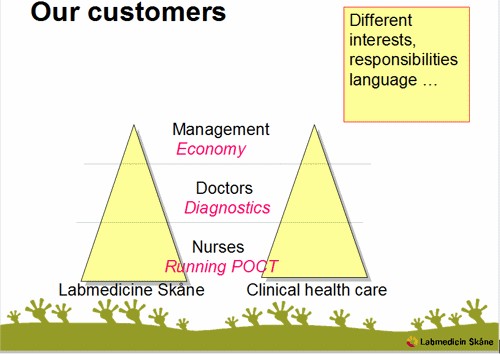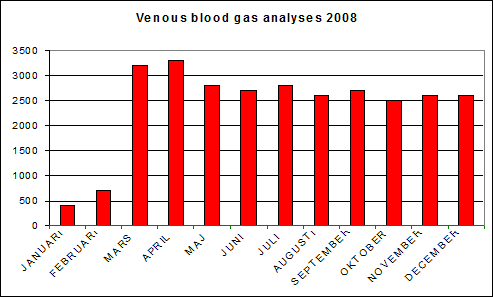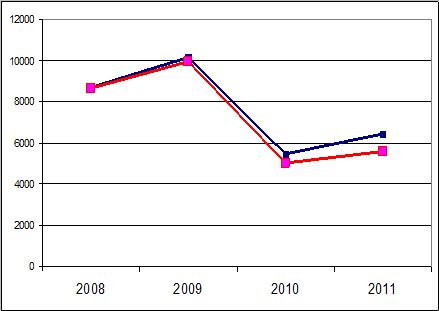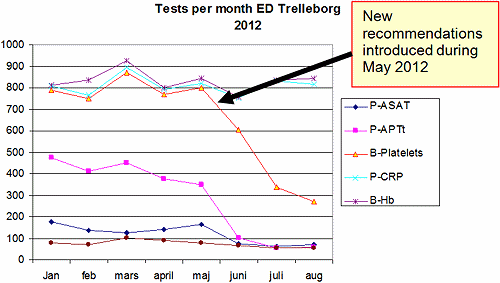Printed from acutecaretesting.org
July 2013
A regional program for POCT service to emergency departments – results and remaining challenges
INTRODUCTION
POCT is now a well-established tool in emergency care. It is used as a logistic supplement to core-lab testing performed by the departments of clinical chemistry. However, it is often organizationally less developed than the laboratory-medicine institutions where there is a long tradition of coordinating many instruments, often at different sites.
POCT is often a stand-alone instrument, possibly under the supervision of a POCT coordinator and with some form of IT connectivity. A systemic coordination of many instruments in different hospitals in a region is not common. As is the case of centralized processes, several improvements can be obtained if a more systematic approach is employed. This is, however, not without its own problems.
BACKGROUND
In the region of Skåne, in southernmost Sweden, healthcare is almost exclusively organized and financed by the regional government. The total population is 1.2 million inhabitants. The healthcare is provided by 10 hospitals, varying in size and scope, from two major university hospital sites to small hospitals with only reduced 24/7 emergency service. In parallel with increased centralization and coordination of clinical medicine, the region’s different laboratories were recently reorganized into one department of laboratory medicine.
Laboratory Medicine of Skåne, founded in 2009, is thus a major organization, engaging in total 1250 co-workers in eight different laboratory specialities. Clinical chemistry is at present the major player in emergency POCT.
POCT programs were run at all hospitals before uniting the laboratories in one organization. A good collaboration existed between the labs, but many local variations had developed. These were often based on different clinical needs but also on different strategies of laboratory management.
Over the last 5 years, not only the organization of the labs has changed, but also medical practice and technology. Operating in the emergency care setting is very much like working with a moving target. Cardiovascular diagnostics evolve continuously and on the technological side the introduction of analysis of venous samples on the blood gas instruments has made it possible to dramatically shift the work flow from the central lab to POCT.
POLITICAL DECISIONS BECAME MANAGEMENT STRATEGIES
After the formation of the new laboratory-medicine organization, a political decision was made to shift some of the responsibilities for POCT to the laboratory:
- Actively participate in and be a knowledge-based support to regional and local healthcare.
- Be responsible for quality assurance and the choice of methods and instruments in point-of-care testing in Region Skåne.
- Agreements shall be signed between healthcare providers and Labmedicine Skåne.
Based on this decision, precious experiences [1] and good clinical interfacing, POCT services were coordinated in the region under one leadership. A 2-year period was needed to unify the different POCT coordinators and the processes in which they worked. This included identical SOPs, IT solutions, training and quality programs.
ANALYZING OUR MARKETS AND CUSTOMERS
Top management organized a “customer group” to help coordinate the multitude of different outreach activities that are ongoing, with the aim of creating a coordinated interface directed to clinicians. The central group made a market and customer analysis. Our markets are roughly divided into four segments. Although there are many common features to these, we found clear differences in demands and needs that we had to approach differently. Emergency care was found to be one of these markets.
Our markets:
- Primary care
- Local hospitals
- Emergency care
- Specialized care
Regarding our different customers we identified three groups and realized that these had to be communicated with by different professionals of the laboratory. It is obvious, but not always taken into consideration, that the daily challenges of a hospital director and an ED nurse differ significantly, as does the competence needed to collaborate with them and to satisfy their needs (Fig. 1).

FIG. 1: Our major customer groups and their main interests.
HARMONIZING THE TEAM AND ITS SERVICES
To make this service a coordinated and identical service, regardless of which hospital we serve, work was done on different fronts. First of all, a team had to be formed by the POCT coordinators who up till 2009 had worked independently. This team is led by a POCT manager and a medically responsible MD.

FIG. 2: POCT team responsible for ED services at 10 hospitals. POCT manager Charlotte Wigermo at the far right.
All procedures were standardized to be used at all EDs. This includes all aspects of running the instruments and creating and keeping the necessary competence among their users. As all hospitals had the same equipment, this was easier than if we had started out with different instrument types. A common system for reimbursement of our services was developed.
In short, we offer a service pack including all aspects of maintaining and quality assuring an instrument at the site of care. For this we charge an annual fee varying depending on the complexity of the instrument. We are now responsible for 32 instruments in the region, five of which are in operation at the major EDs. The service we provide is appreciated and we have no clinical departments that object to signing the agreement.
NEW WORK FLOW WITH MAJOR IMPACT
The introduction of high-volume analysis of venous blood samples on blood gas analyzers has changed the flow of samples and the sites at which they are processed. With the introduction of modules for creatinine it is now possible to obtain a basic biochemical panel within minutes using POCT [2].
Until 2008 almost all blood gas tests were done on arterial samples. The introduction of the new routine dramatically changed the concept of what a blood gas instrument is. It is now a “lab in a box” for the initial triage of most patients at an ED.

FIG. 3: Standardized panel of tests obtained on venous blood at ED.
Currently, 130,000 venous blood gas analyses are performed in the major EDs, generating more than a million test results annually. The total number of patients at these sites is approximately 200,000, an indication that a venous blood gas test is performed on 2/3 of all patients admitted.
At the smaller hospitals, with reduced emergency care service, the tests are performed in a similar process by the local laboratory, which is usually situated adjacent to the EDs. In addition to these tests, POCT is also used for CRP and urine analysis, but not for cardiac markers.

FIG. 4: Number of blood gas analyses performed monthly in 2008 at one ED. Note the increase in March after the introduction of triage. The number of samples has since increased and is now approximately 5000 per month at this ED.
The changed logistics have effects on the work load of the central laboratory. The number of STAT creatinine and sodium was reduced by approximately 30 %, but this effect was delayed by one year. A possible explanation is that clinicians initially were not confident with the quality of the POCT and needed a period of clinical validation. As a consequence of this reduction the economic reimbursement to the laboratory was reduced.
However, as the total number of these routine tests is high, including a vast number of primary care samples, the total effect was in most sites not dramatic. In a laboratory with a low outreach service this can have grave consequences that need to be addressed rapidly.

FIG. 5: Annual production of STAT analyses of creatinine and sodium was reduced one year after the introduction in 2008 of venous blood gas analysis POCT at one ED.
NEW CHALLENGES TO BE ADDRESSED
The general effects on different aspects of care have been positive but some aspects need further work and continuous improvement.
A. Detection of hemolysis
It is well known that preanalytical errors such as hemolysis are more common in the emergency situation. The problem is most obvious with regard to potassium, and approximately 5 % of ED samples have a degree of hemolysis that may affect the clinical interpretation of the result. With 130,000 potassium results generated annually many thousands could be incorrect and constitute a medical hazard.
B. Transferability of results
This aspect is in no way new to the field of POCT. We have over the years followed it at the different hospitals. However, due to the vast increase of the number of results, and results of crucial medical importance, the question is further highlighted. In our region an increasing number medical decisions is made on a mix of core-lab and POCT results, sometimes performed at different hospitals and EDs.
To reduce the bias between methods is necessary, and a first step is a regional program to monitor transferability of results. Although validation studies have shown acceptable transferability, we have on several occasions detected deviations of clinical importance. Split sample techniques can be useful for this purpose but is not practically applicable on a healthcare system in a geographical region, as some of the components will not tolerate necessary transports. A QA system spanning the region and all of its instruments and instrument types is a first step.
C. New hospital-spanning IT system
Currently we have four different IT systems in the region. It is difficult to follow the quality and problems under these conditions. A unifying system would greatly increase quality and efficiency. Needless to say, such a crucial system will have to be very reliable as any problem would disturb essential medical care in the region it is to serve. This system must also be connectable to all instruments, from blood gas analyzers to small handheld devices. All results must easily be reviewed and all instruments available for troubleshooting from one site in the regional system, and from the service organization of the manufacturer.
We are currently in the process of introducing an appropriate IT system, but implementing it region-wide on several thousand instruments in 10 hospitals and 150 health centers will be a long and challenging endeavor.
D. New diagnostic strategies – and getting rid of the obsolete ones
The medical aspects of POCT are ever-present but often not prioritized. New technologies are introduced, but the diagnostic strategies and algorithms seldom questioned. Likewise, new approaches are introduced without a thorough analysis and discussion between laboratory and clinical experts.
A number of questions are now discussed in good collaboration between clinical and laboratory doctors in our region. New POCT applications have been analyzed. We have studied the pros and cons of POCT troponins in the ED but jointly decided not to introduce them. There are a number of reasons for this conclusion. The costs would increase and the reduced TAT is not considered to be of major importance in most cases.
Importantly, present methods are not sensitive enough to give results that are transferable to those of laboratory high-sensitivity troponins. This situation may very well change and the decision revised. But it is a clear demand of the ED clinicians to have identical methods and decision limits, in order to reduce the risk of not detecting acute coronary heart disorders.
Panels of test can be useful to standardize routine clinical situations and we have now revised the panels to be used initially to triage patients with hepatic, gastrointestinal, urinary and infection symptoms.
In connection with this revision we have also analyzed the pattern of ordering tests at the EDs. It is evident that some tests are ordered merely as an old routine and without updated medical evidence. Some tests, like AST, can be omitted in this context while others reduced significantly and used only in selected cases.
In one of the smaller hospitals new recommendations had a very rapid effect on the number tests ordered for components such as AST APT-time, platelets and D-dimer (Fig. 6). Most of these tests are inexpensive but as the number of tests is high, significant economic gains can be made.

FIG. 6: The effect of new clinical recommendations on ordering of some tests at ED.
CONCLUSIONS
Going from a hospital-based to a regional POCT system is not only a question of scaling up present procedures but consideration has to be taken to a number of both old and new issues. It is important to keep in mind that more can be different, and have to be handled in a structured and customer-oriented way.
References
- Strandberg K, Thämlitz R, Simonsson P. A systematic approach to point of care blood gas analyses - the Malmo experience. Point of Care: The Journal of Near-Patient Testing & Technology 2003; 2: 220-24.
- Shephard MDS. Point-of-care testing and creatinine measurement. Clin Biochem Rev 2011; 32: 109-14.
References
- Strandberg K, Thämlitz R, Simonsson P. A systematic approach to point of care blood gas analyses - the Malmo experience. Point of Care: The Journal of Near-Patient Testing & Technology 2003; 2: 220-24.
- Shephard MDS. Point-of-care testing and creatinine measurement. Clin Biochem Rev 2011; 32: 109-14.
May contain information that is not supported by performance and intended use claims of Radiometer's products. See also Legal info.
Scientific webinars
Check out the list of webinars
Radiometer and acutecaretesting.org present free educational webinars on topics surrounding acute care testing presented by international experts.
Go to webinarsAcute care testing handbook
Get the acute care testing handbook
Your practical guide to critical parameters in acute care testing.
Download nowRelated webinar
Evolution of blood gas testing Part 1
Presented by Ellis Jacobs, PhD, Assoc. Professor of Pathology, NYU School of Medicine.
Watch the webinar










